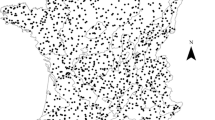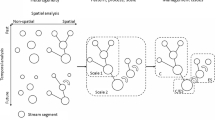Abstract
We describe a framework called Regional Hydrologic Modeling for Environmental Evaluation (RHyME2) for hydrologic modeling across scales. Rooted from hierarchy theory, RHyME2 acknowledges the rate-based hierarchical structure of hydrological systems. Operationally, hierarchical constraints are accounted for and explicitly described in models put together into RHyME2. We illustrate RHyME2with a two-module model to quantify annual nutrient loads in stream networks and watersheds at regional and subregional levels. High values of R2 (>0.95) and the Nash–Sutcliffe model efficiency coefficient (>0.85) and a systematic connection between the two modules show that the hierarchy theory-based RHyME2 framework can be used effectively for developing and connecting hydrologic models to analyze the dynamics of hydrologic systems.





Similar content being viewed by others
Notes
Bootstrap analysis involves resampling with replacement from among the original size-n dataset (e.g., the 81-point and 576-point datasets in steps (c) and (e)) to create samples with the same size n in all iterations (Davison and Hinkley 1997).
References
Alexander RB, Smith RA, Schwarz CA (2000) Effect of stream channel size on the delivery of nitrogen to the Gulf of Mexico. Nature 403:758–761
Alexander RB, Smith RA, Schwarz GE, Boyer EW, Nolan JV, Brakebill JW (2008) Differences in phosphorus and nitrogen delivery to the Gulf of Mexico from the Mississippi River Basin. Environ Sci Technol 42(3):822–830
Allen TFH, Starr TB (1982) Hierarchy: perspectives for ecological complexity. University of Chicago Press, Chicago
Arnold JG, Williams JR, Nicks AD, Sammons NB (1990) SWRRB—A basin scale simulation model for soil and water resources management. Texas A&M University Press, College Station
Aulenbach, BT, Buxton HT, Battaglin WA, Coupe RH (2007) Streamflow and nutrient fluxes of the Mississippi–Atchafalaya River Basin and sub–basins for the period of record through 2005, U.S. Geol. Surv. Open File Rep., 2007–1080
Basu NB et al (2010) Nutrient loads exported from managed catchments reveal emergent biogeochemical stationarity. Geophys Res Lett 37(L23404):1–5
Beven K (1987) Towards a new paradigm in hydrology, Water for the Future: Hydrology in perspective (Proceedings of the Rome Symposium, April 1987). IAHS Publ. no.164
Beven K (2001) How far can we go in distributed hydrological modelling? Hydrol Earth Syst Sci 5(1):1–12
Beven K (2002) Towards an alternative blueprint for a physically based digitally simulated hydrologic response modeling system. Hydrol Process 16:189–206
Bicknell BR, Imhoff JC, Kittle JL Jr, Jobes TH, Donigian AS Jr (2001) Hydrological simulation program-Fortran, HSPF version 12 user’s manual. AQUA TERRA Consultants, Mountain View, 873p
Blöschl G (2001) Scaling in hydrology. Hydrol Process 15:709–711
Caraco NF, Cole JJ, Likens GE, Lovett GM, Weathers KC (2003) Variation in NO3 export from flowing waters of vastly different sizes—Does one model fit all? Ecosystems 6:344–352
Daly C, Taylor G (1998) United States average monthly or annual precipitation, 1961–90. Spatial Climate Analysis Service at Oregon State University, Corvallis
Davison AC, Hinkley D (1997) Bootstrap methods and their application. Cambridge Series in Statistical and Probabilistic Mathematics, Cambridge
Gaddis EJB, Voinov A (2010) Spatially explicit modeling of land use specific Phosphorus transport pathways to improve TMDL load estimates and implementation planning. Water Resour Manag 24:1621–1644
García AM, Hoos AB, Terziotti S (2011) A regional modeling framework of phosphorus sources and transport in streams of the Southeastern United States. JAWRA J Am Water Resour Assoc. doi:10.1111/j.1752-1688.2010.00517.x
Gentine P, Troy TJ, Lintner BR, Findell KL (2012) Scaling in surface hydrology: progress and challenges. J Contemporary Water Res Education 147:28–40
Gibson CA, Meyer JL (2007) Nutrient uptake in a large urban river. J Am Water Resour Assoc 43(3):576–587
Goolsby DA, Battaglin WA (2001) Long-term changes in concentrations and flux of nitrogen in the Mississippi River basin, USA. Hydrol Process 15(7):1209–1226
Hoos AB, McMahon G (2009) Spatial analysis of instream nitrogen loads and factors controlling nitrogen delivery to streams in the southeastern United States using spatially referenced regression on watershed attributes (SPARROW) and regional classification frameworks. Hydrologic Processes. doi:10.1002/hyp.7323
Howarth et al (1996) Regional nitrogen budgets and riverine N and P fluxes for the drainages to the North Atlantic Ocean—natural and human influences. Biogeochemistry 35:75–139
MathWorks (2011), MatLab User Guide, Available at http://www.mathworks.com/help/techdoc/matlab_product_page.html
McMahon G, Alexander RB, Qian S (2003) Support of TMDL programs using spatially referenced regression models. ASCE J Water Resour Plann Manag 129:315–329
Moore RB, Johnston CM, Robinson KW, Deacon JR (2004) Estimation of total nitrogen and phosphorus in New England streams using spatially referenced regression models, U.S. Geological Survey Scientific Investigations Report 2004–5012, 50p
Mulholland PJ et al (2008) Stream denitrification across biomes and its response to anthropogenic nitrate loading. Nature 452:202–205
Mulholland PJ et al (2009) Nitrate removal in stream ecosystems measured by 15 N addition experiments: denitrification. Limnol Oceanogr 54(3):666–680
Nash JE, Sutcliffe JV (1970) River flow forecasting through conceptual models part I — A discussion of principles. J Hydrol 10(3):282–290
O’Neill RV, DeAngelis DL, Waide JB, Allen TFH (1986) A hierarchical concept of ecosystems. Princeton University Press, Princeton
Overton WS (1974) Decomposability: a unifying concept? In: Levin SA (ed) Ecosystem analysis and prediction. SIAM, Philadelphia, pp 297–298
Perveen S, James LA (2010) Multiscale effects on spatial variability metrics in global water resources data. Water Resour Manag 24:1903–1924
Preston SD, Brakebill JW (1999) Application of spatially referenced regression modeling for the evaluation of total nitrogen loading in the Chesapeake Bay watershed. U.S. Geological Survey Water-Resources Investigations Report 99–4054, 12p
Ruddy BC, Lorenz DL, Mueller DK (2006) County-Level Estimates of Nutrient Inputs to the Land Surface of the Conterminous United States, 1982–2001. U.S. Geological Survey Scientific Investigations Report 2006–5012, 17 p
Schwarz GE, Hoos AB, Alexander RB, Smith RA (2006) The SPARROW surface water-quality model: Theory, application and user documentation, U.S. Geological Survey Techniques and Methods Report, Book 6, Chapter B3, 2006
Simon HA (1962) The architecture of complexity. Proc Am Philos Soc 106:467–482
Simon HA (1969) The sciences of the artificial. MIT Press, Cambridge
Simon HA (1973) The organization of complex systems. In: Pattee HH (ed) Hierarchy theory. Braziller, New York, pp 3–27
Smith RA, Schwarz GE, Alexander RB (1997) Regional interpretation of water-quality monitoring data. Water Resour Res 33(12):2781–2798
Thampi SG, Raneesh KY, Surya TV (2010) Influence of scale on SWAT model calibration for streamflow in a river basin in the humid tropics. Water Resour Manag 24:4567–4578
USEPA and USGS (2006) National Hydrography Dataset Plus (NHDPlus). Available at http://www.horizon-systems.com/nhdplus/
Vogelmann JE et al (2001) Completion of the 1990’s national land cover data set for the conterminous United States. Photogramm Eng Remote Sens 67:650–662
Xu CY, Singh VP (2004) Review on regional water resources assessment models under stationary and changing climate. Water Resour Manag 18:591–612
Yevjevic V (1991) Tendencies in hydrology research and its applications for 21st century. Water Resour Manag 5:1–23
Author information
Authors and Affiliations
Corresponding author
Rights and permissions
About this article
Cite this article
Tran, L.T., O’Neill, R.V., Smith, E.R. et al. Application of Hierarchy Theory to Cross-Scale Hydrologic Modeling of Nutrient Loads. Water Resour Manage 27, 1601–1617 (2013). https://doi.org/10.1007/s11269-013-0260-0
Received:
Accepted:
Published:
Issue Date:
DOI: https://doi.org/10.1007/s11269-013-0260-0




